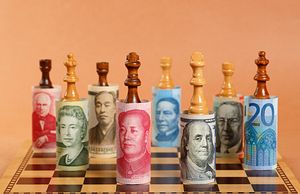Concern about capital outflows from China is rising, as the RMB depreciates and the real economy loses steam. Foreign and domestic investors who had previously banked on RMB appreciation or simply invested in RMB-denominated assets now wish to move money out of the Chinese currency. How can China-watchers interpret capital outflows and regulators’ actions to contain them?
Currency depreciation against the dollar has occurred as a result of changing the exchange rate measure to reflect less dollar correlation and more weighting toward a basket of thirteen currencies, including the dollar, euro, and yen, which comprise the largest shares, and the Hong Kong dollar, the British pound, the Australian dollar, the New Zealand dollar, the Singapore dollar, the Swiss franc, the Canadian dollar, the Malaysian ringgit, the ruble, and the Thai baht. Analysts have speculated that China has moved RMB weighting toward the euro, which has depreciated against the dollar through 2015 and early 2016. The move back toward using a basket of currencies to weight the RMB from a focus on the dollar has been put into place to allow the RMB to better reflect market conditions; in this case, the currency is trade-weighted.
RMB depreciation is also a reflection of China’s declining economic conditions. China’s growth is at its slowest in 25 years and recent stock market performance has been abysmal. Sales, pricing, profits, hiring, and borrowing have all taken a hit as the economy weakens. This has induced investors to look elsewhere for profitable opportunities, particularly as it is unclear when and how restructuring plans toward a service-based economy will come to fruition. Low interest rates have also induced investors to move elsewhere in a search for higher yield.
The central bank has attempted to stave off speculation, particularly in the offshore RMB (CNH) by purchasing RMB through state-owned banks in Hong Kong. The People’s Bank of China (PBOC) has also stated that it will begin to implement a required reserve ratio (RRR) on offshore banks’ domestic deposits for the same purpose. The PBOC has also attempted to bolster the value of the onshore RMB amid surging capital outflows.
This heavy intervention belies China’s commitment to liberalizing its exchange rate, especially after the IMF included the RMB in the basket of reserve currencies. Mixed messages associated with China’s exchange rate have only added to the uncertainty surrounding China’s economic direction. Under conditions of volatility, it seems that central bank intervention is de rigueur. What is not known is what will happen once the economy stabilizes; will the exchange rate be allowed to wobble on capital outflows, or not?
Chinese regulators have attempted to curb legal capital outflows from banks, requiring banks to rigorously check corporate business transactions. Furthermore, although a large percentage of capital outflows are legal due to significant openness of the capital account, remaining capital controls continue to give rise to illegal capital outflows. Regulators have been cracking down on illegal cross-border outflows disguised as trade transactions. This battle will likely continue as long as China’s economy remains weak and exchange rate expectations remain negative.
The fight against economic fragility has in important ways prolonged the reform process, especially the turn toward financial liberalization. Should interest rates be set low to improve economic conditions, or set high to reduce capital outflows? Should the exchange rate be allowed to fluctuate on speculative forces, or should instability be the controlled? Ironically, the same forces that prevail upon the RMB to depreciate would give exports a significant boost, pumping up the real economy. Despite some analysts’ beliefs that China has depreciated to buoy exports, this does not seem to be the ultimate aim. China does appear to be headed away from a manufacturing and export-based economy, but slowly. Exchange rate liberalization is occurring, but at a microscopic pace in spite of IMF’s exhortations to liberalize faster.
The rate of change is dissatisfying to those calling for reform and shocking to those who demand greater stability. These contradicting forces may last through the year as China restructures and finds a healthier balance between market and government control.

































